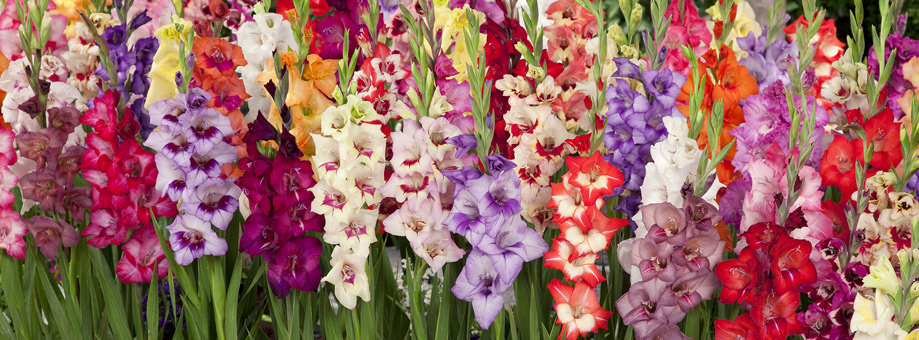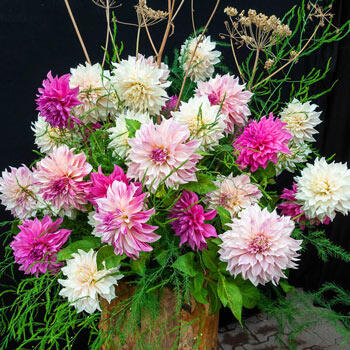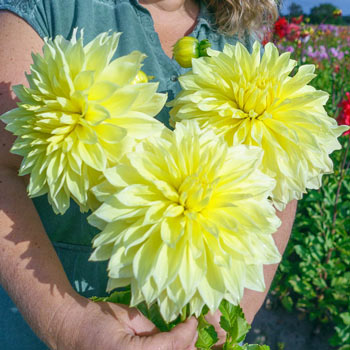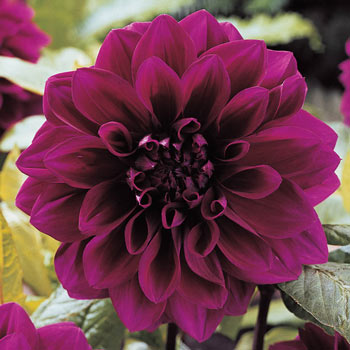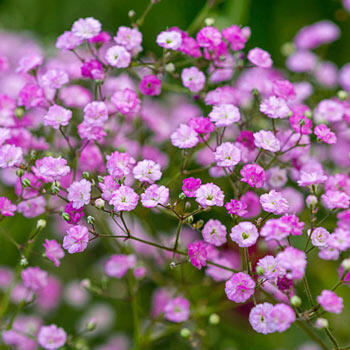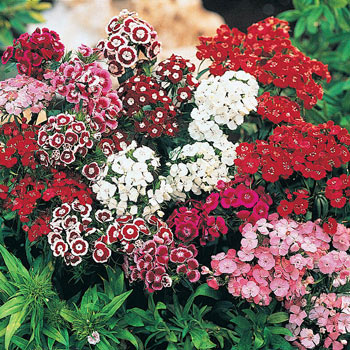- About Bulbs
- Landscaping Tips
- Planting & Care of Bulbs
- Tips for buying Bulbs & Perennials
- Planting & Growing Instructions
- Allium Planting and Growing Tips
- Begonias Planting and Growing Tips
- Calla Lily Planting and Growing Tips
- Crocus Planting and Growing Tips
- Daffodil Planting and Growing Tips
- Dahlia Planting and Growing Tips
- Daylily Planting and Growing Tips
- Gladiolus Planting and Growing Tips
- Hyacinth Planting and Growing Tips
- Iris Planting and Growing Tips
- Lily Planting and Growing Tips
- Peony Planting and Growing Tips
- Rose Planting and Growing Tips
- Tulip Planting and Growing Tips
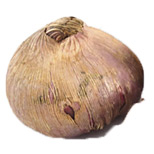
Where to Plant Gladiolus Flowers
Gladiolus flowers are native to South Africa and yield the largest and most colourful flowers when planted where they will receive full sun. Try growing them in a flower bed, cut-flower garden or border that receives lots of sunshine. Gladiolus even do well outdoors in containers resting in direct sunlight. They prefer well-drained, sandy loam and do not fare well in soggy soil.How to Plant Gladiolus Bulbs
- To plant gladiolus bulbs, start with Breck's Plant Food to the trench.
- Cover with 2" of soil.
- Firmly place the Gladiolus bulbs on soil, pointed ends up, 6" apart.
- In a flower border, plant a group of at least 10 gladiolus bulbs for the best effect.
- Cover with remaining soil.
- Water well and add 2" of mulch to conserve moisture and keep the roots cool.
Common Gladiolus Flower Pests
- Aphids
- Mealybugs
- Scale
- Thrips
- White flies
- Beetles
- Caterpillars
- Grasshoppers
- Snails and slugs
- Bulb mites
- Tulip bulb aphids
- Root-knot nematodes
Unfortunately for gardeners, there are a number of tiny bugs that feed on gladiolus flowers by piercing the stem or leaves. These insects include aphids, mealybugs, scale, thrips and white flies. Signs of bug damage include yellow or white spots, and leaves turning yellow or withering and falling. Try spraying pests with a strong stream of water, then use a natural pesticide on the flowers. Apply the pesticide weekly for heavy infestations and every other week for light infestations.
Larger insects also eat gladiolus flowers and leaves. They include beetles, caterpillars and grasshoppers. The best way to get rid of them is to put on your gardening gloves and remove them by hand, dropping them in a bucket of water to drown them. Another tip: remove any weeds growing near your gladiolus. Caterpillars often climb weeds to access gladiolus.
Snails and slugs come out at night to eat gladiolus flowers. They should also be removed by hand, at night with the aid of a flashlight. Place them in a bucket of soapy water to drown them.
Bulb mites, tulip bulb aphids and root-knot nematodes live in the soil and attack gladiolus corms and roots. Check for signs of these insect pests before planting or storing them. If you see bugs on the bulbs, shake off as much of the dirt as you can and then cover them with neem oil.
Common Gladiolus Diseases
If your gladiolus flowers appear stunted or if the leaves begin yellowing, it's possible that your gladiolus beauties have a virus or disease. When a gladiolus catches a virus, you may have to dig them up and plant new ones. One thing to look for when planting your gladiolus corms are whether or not your corms feel super soft or even crumbly. If this is the case, you should not plant them and should throw them out. Some common gladiolus diseases to look out for include:Botrytis Blight
This type of disease appears as reddish brown spots on the leaves of your gladiolus flowers. These spots are usually really small but can also grow to over a ½ inch.Curvularia Leaf Spot
This disease appears as a tan, rectangular, and long spot on gladiolus leaves. This tannish spot is often accompanied by a yellowish halo. If the corms are rotting, this is also a good inidictaion that your gladiolus may have this disease.Fusarium Yellows
If your flower's growth appears to be stunted or if the flowers are not developing normally, your gladiolus may have a fusarium yellows disease. With this disease, the roots of the flower will brown and appear rotted. Stalks may also be curving in an S-shape.Viruses
Gladiolus flowers that are exposed to pests and insects or flowers that are planted among weeds and nematodes are likely to catch a virus. Viruses generally appear as mottled, reddish leaves that may have white spots, abnormal or discolored flower petals.When to Plant Gladiolus Bulbs
Begin planting your gladiolus bulbs in mid-spring and continue to plant every two weeks until mid-July to enjoy stunning flowers throughout the summer months.When do Gladiolus Flowers Bloom?
Gladiolus bulbs will bloom from 70-100 days from planting, depending on the lateness in the season. Tall-growing varieties may need staking. Water the gladiolus flowers well throughout the growing season. Fertilize when the flower spikes first appear and after the flowers are picked.Gladiolus Winter Storage Tips
Gladiolus is a perennial plant that dies back each year and then regrows the following year. While hardy in Zones 8-11, other growers should dig up their bulbs, known as corms, 4-6 weeks after the flowers fade. Remove as much soil as possible and cut off the flower stalk 1" above the corm. Dry the gladiolus bulbs outdoors for a few weeks, layer them in peat moss, place them in paper bags and then store them indoors in a dry, well-ventilated location that is consistently around 40-50°F. Make sure they do not freeze or you will risk killing them. Before replanting Gladiolus bulbs in the spring, remove any dried bits from last year's corms.
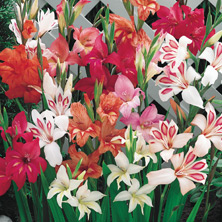
How to Plant Other Varieties of Gladiolus
How to Plant Hardy Gladiolus
Hardy Glads - In fall, plant in almost any type of well-drained garden soil in full sun. Plant the corms 4-6" apart in clumps approximately 3" deep. Fertilize when planting with any 5-10-5 fertilizer but avoid animal manure since it may encourage rot. Mulch over the winter for protection. Hardy in Zones 5-10.

How to Plant Glamini Gladiolus
Glamini Glads - Glaminis are highly pest resistant and bloom happily in full sun or partial shade. Their shorter overall height means you can use them in the middle or fronts of borders and beds. They also do exceptionally well in patio containers - or even window boxes where viewing their rich cascades of 3-4" flowers up close is a special pleasure. Glaminis are also splendid in your vase. Care is no more difficult than for any gladiolus. Simply plant 3" deep in sun or partial shade and space 3-4" apart. Glaminis can be lifted approximately 8-10 weeks after flowering. Dry the bulbs and let them overwinter in a cool, dark, frost-free location.How can I extend the flowering period of gladiolus?
Plant bulbs in two-week intervals. This will also result in the continuous availability of fresh-cut flowers.When can I use my gladiolus as cut flowers?
Cut flower spikes when only one or two flowers are open. Leave at least 5" on the plant so the bulb can regenerate well next year.How do I cut my gladiolus for use in a vase?
Cut flower spikes cleanly at a slight angle and then place them in a vase with plenty of water. Fresh-cut gladiolus require a lot of water to stay fresh, so remember to watch the water level in the vase.How do I clean my gladiolus bulbs for winter storage?
When you dig up the bulbs, you may notice a new corm has formed on top of the old one. Dry them outdoors for a few weeks, which should allow you to easily remove the new corms from the old ones. Discard any that show signs of rot. The remaining bulbs should be dried further to cure the new scar, before storing indoors.More Information About Gladiolus from Herman's Nursery
You May Like...







